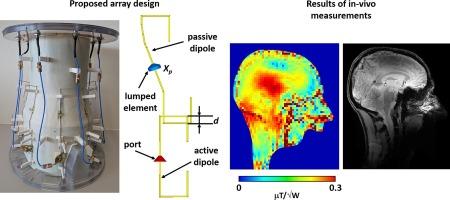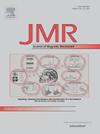用于 9.4 T 全脑成像的成对折叠端偶极子阵列
IF 2
3区 化学
Q3 BIOCHEMICAL RESEARCH METHODS
引用次数: 0
摘要
目的为了改善人体头部射频阵列的发射 B1+ 场均匀性和纵向覆盖范围,我们开发了一种新型八元件收发器(TxRx)阵列,该阵列采用基于成对折叠端偶极子的复合元件。每对偶极子中只有一个在传输过程中被驱动,而另一个则与主动偶极子被动耦合。通过改变偶极子之间的重叠度和置于被动偶极子中间的反应块状元件的值,对发射 B1+ 场的分布进行了数值优化。结果与单排折端偶极子阵列相比,所提出的成对折端偶极子阵列大大提高了 B1+ 的均匀性和对包括脑干在内的整个大脑的纵向覆盖。结论 作为概念验证,我们开发了一种用于人脑成像的单排八元件 9.4 T 阵列原型,并对其进行了数值和实验表征,该阵列由基于成对被动耦合折端偶极子的复合阵元组成。由于每个通道由一个有源偶极子和一个无源偶极子形成横向拉长的磁场模式,该阵列改善了发射磁场分布。因此,其覆盖范围大大优于由长折端偶极子组成的 8 元偶极子阵列。利用一个简单的单排八元件阵列,首次在 9.4 T 下获得了整个人脑的图像,覆盖范围从脑干一直到第四节脊椎骨。本文章由计算机程序翻译,如有差异,请以英文原文为准。

An array of paired folded-end dipoles for whole-brain imaging at 9.4 T
Purpose
To improve transmit B1+ field homogeneity and longitudinal coverage of a human head RF array, we developed a novel eight-element transceiver (TxRx) array using composite elements based on paired folded-end dipoles.
Methods
The developed array consisted of eight pairs of coupled folded-end dipoles. Only one dipole in each pair was driven during transmission, while the other was passively coupled with the active one. The distribution of the transmit B1+ field was numerically optimized by changing the overlap between the dipoles and the value of the reactive lumped element placed in the middle of the passive dipole.
Results
The proposed array of paired folded-end dipoles substantially improved the B1+ homogeneity and longitudinal coverage over the entire brain including the brain stem compared to a single-row folded-end dipole array. The improved whole brain coverage was demonstrated both numerically and experimentally.
Conclusion
As a proof of concept, we developed and characterized both numerically and experimentally a prototype of a single-row eight-element 9.4 T array for human brain imaging consisting of composite array elements based on paired passively-coupled folded-end dipoles. The array improved the transmit magnetic field distribution due to the laterally elongated field pattern created by one active and one passive dipole per channel. As a result, the provided coverage was substantially better than that of an 8-element dipole array consisting of long folded-end dipoles. For the first time, an image of the entire human brain at 9.4 T, covering the brain stem up to the fourth vertebra, was obtained using a simple single row eight-element array.
求助全文
通过发布文献求助,成功后即可免费获取论文全文。
去求助
来源期刊
CiteScore
3.80
自引率
13.60%
发文量
150
审稿时长
69 days
期刊介绍:
The Journal of Magnetic Resonance presents original technical and scientific papers in all aspects of magnetic resonance, including nuclear magnetic resonance spectroscopy (NMR) of solids and liquids, electron spin/paramagnetic resonance (EPR), in vivo magnetic resonance imaging (MRI) and spectroscopy (MRS), nuclear quadrupole resonance (NQR) and magnetic resonance phenomena at nearly zero fields or in combination with optics. The Journal''s main aims include deepening the physical principles underlying all these spectroscopies, publishing significant theoretical and experimental results leading to spectral and spatial progress in these areas, and opening new MR-based applications in chemistry, biology and medicine. The Journal also seeks descriptions of novel apparatuses, new experimental protocols, and new procedures of data analysis and interpretation - including computational and quantum-mechanical methods - capable of advancing MR spectroscopy and imaging.

 求助内容:
求助内容: 应助结果提醒方式:
应助结果提醒方式:


